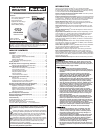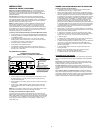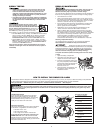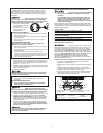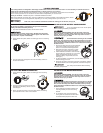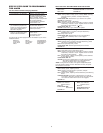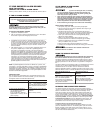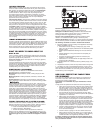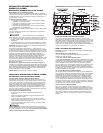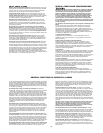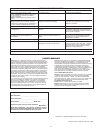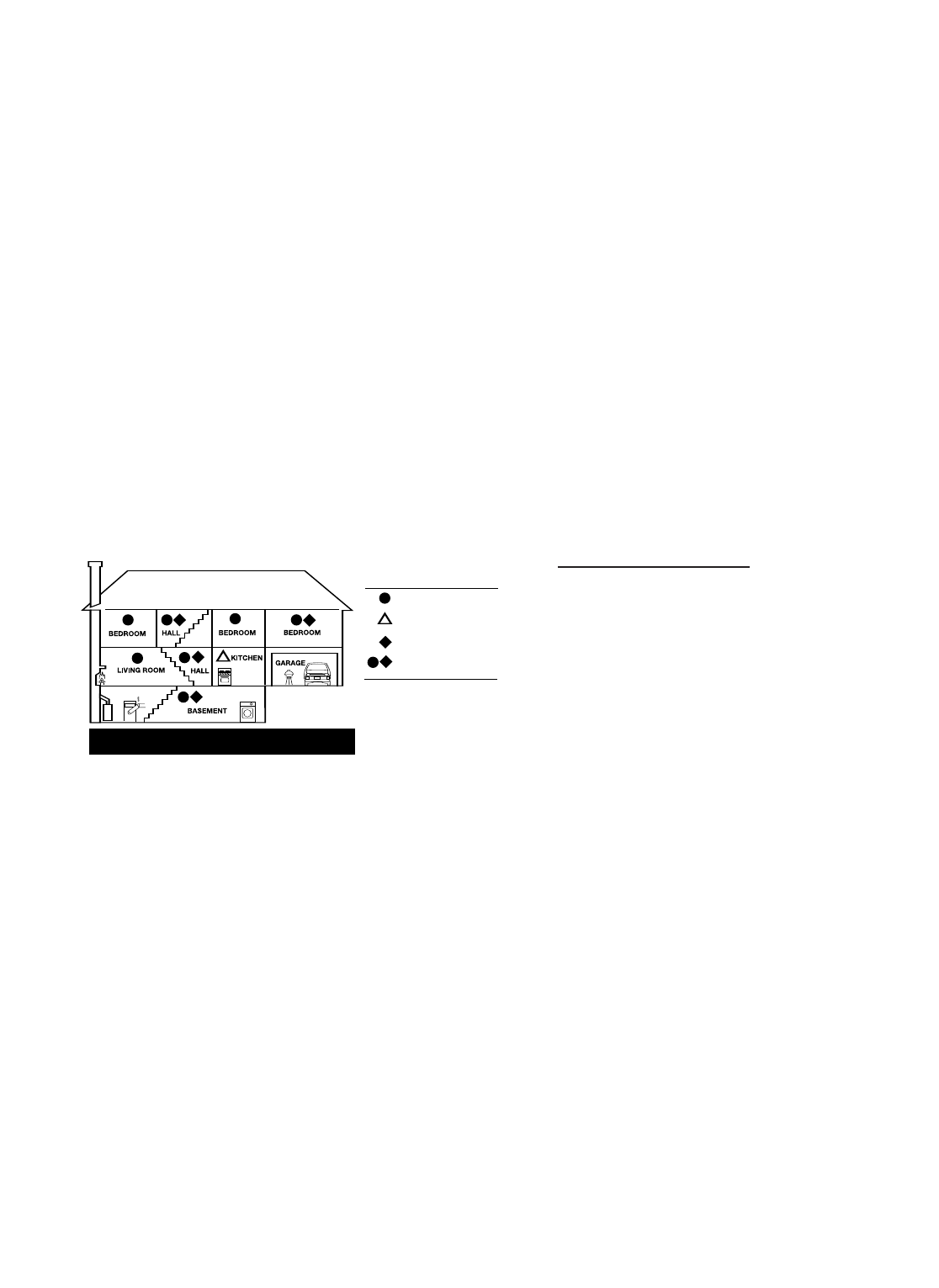
2
INSTALLATION
WHERE TO INSTALL THIS ALARM
M
inimum coverage for Smoke Alarms
,
as recommended by the
N
ational Fire Protection Association (NFPA), is one Smoke Alarm on
every floor, in every sleeping area, and in every bedroom (See
“
Regulatory Information For Smoke Alarms” for details on the NFPA
r
ecommendations).
F
or CO Alarms,
t
he National Fire Protection Association (NFPA)
recommends that a CO Alarm should be centrally located outside of
e
ach separate sleeping area in the immediate vicinity of the bedrooms.
F
or added protection, install additional CO Alarms in each separate
bedroom, and on every level of your home.
N
OTE:
F
or added protection, install an additional Smoke/CO Alarm at
l
east 15 feet (4.6 meters) away from the furnace or fuel burning heat
source where possible. In smaller homes or in manufactured homes
w
here this distance cannot be maintained, install the Alarm as far away
a
s possible from the furnace or other fuel burning source. Installing the
Alarm closer than 15 feet (4.6 meters) will not harm the Alarm, but may
i
ncrease the frequency of unwanted alarms.
I
n general, install combination Smoke and Carbon Monoxide Alarms:
•
On every level of your home, including finished attics and basements.
• Inside every bedroom, especially if people sleep with the door partly
o
r completely closed.
•
In the hall near every sleeping area. If your home has multiple
sleeping areas, install a unit in each. If a hall is more than 40 feet
(12 meters) long, install a unit at each end.
• At the top of first-to-second floor stairs.
•
A
t the bottom of the basement stairs.
•
F
or additional coverage, install Alarms in all rooms, halls, and
storage areas, where temperatures normally remain between 40˚ F
and 100˚ F (4˚ C and 38˚ C).
RECOMMENDED PLACEMENT
• When installing on the wall, the top edge of Smoke Alarms should
be placed between 4 inches (102 mm) and 12 inches (305 mm)
from the wall/ceiling line.
• When installing on the ceiling, place the alarm as close to the center
as possible.
•
In either case, install at least 4 inches (102 mm) from where the
wall and ceiling meet. See “A
voiding Dead Air Spaces” for more
information.
NOTE: For any location, make sure no door or other obstruction could
keep carbon monoxide or smoke from reaching the Alarm.
Installing Smoke/CO Alarms in Mobile Homes
For minimum security install one Smoke/CO Alarm as close to each
sleeping area as possible. For more security, put one unit in each room.
Many older mobile homes (especially those built befor
e 1978) have little
or no insulation. If your mobile home is not well insulated, or if you are
unsure of the amount of insulation, it is important to install units on
inside walls only.
SUGGESTED AREAS FOR INSTALLING
SMOKE ALARMS, CO ALARMS, AND COMBO UNITS
S
MOKE ALARM WITH
SILENCE FEATURE
CO ALARMS
BOTH, OR COMBINATION
SMOKE/CO ALARMS
SMOKE ALARMS
KEY:
Suggested locations are based on
NFPA recommendations (NFPA 72
f
or Smoke Alarms and NFPA 720 for
Carbon Monoxide Alarms). Always
refer to national and local codes
before beginning any installation.
In new construction AC and AC/DC smoke alarms MUST
be interconnected to meet NFPA recommendations.
W
HERE THIS ALARM SHOULD NOT BE INSTALLED
D
o NOT locate this Smoke/CO Alarm:
•
In garages, furnace rooms, crawl spaces and unfinished attics.
A
void extremely dusty, dirty or greasy areas.
•
Where combustion particles are produced. Combustion particles
f
orm when something burns. Areas to avoid include poorly ventilated
kitchens, garages, and furnace rooms. Keep units at least 20 feet
(
6 meters) from the sources of combustion particles (stove, furnace,
w
ater heater, space heater) if possible. In areas where a 20-foot
(6 meter) distance is not possible – in modular, mobile, or smaller
h
omes, for example – it is recommended the Smoke Alarm be
p
laced as far from these fuel-burning sources as possible. The
placement recommendations are intended to keep these Alarms at
a
reasonable distance from a fuel-burning source, and thus reduce
“
unwanted” alarms. Unwanted alarms can occur if a Smoke Alarm
is placed directly next to a fuel-burning source. Ventilate these
a
reas as much as possible.
•
Within 5 feet (1.5 meters) of any cooking appliance. In air streams
n
ear kitchens. Air currents can draw cooking smoke into the smoke
sensor and cause unwanted alarms.
• In extremely humid areas. This Alarm should be at least 10 feet
(3 meters) from a shower, sauna, humidifier, vaporizer, dishwasher,
l
aundry room, utility room, or other source of high humidity.
•
In direct sunlight.
• In turbulent air, like near ceiling fans or open windows. Blowing air
m
ay prevent CO or smoke from reaching the sensors.
•
In areas where temperature is colder than 40˚ F (4˚ C) or hotter than
100˚ F (38˚ C). These areas include non-airconditioned crawl
spaces, unfinished attics, uninsulated or poorly insulated ceilings,
p
orches, and garages.
• In insect infested areas. Insects can clog the openings to the
s
ensing chamber.
•
Less than 12 inches (305 mm) away from fluorescent lights.
Electrical “noise” can interfere with the sensor.
• In “dead air” spaces. See “Avoiding Dead Air Spaces”.
AVOIDING DEAD AIR SPACES
“Dead air” spaces may prevent smoke from reaching the Smoke/CO
Alarm. To avoid dead air spaces, follow installation recommendations
below.
On ceilings, install Smoke/CO Alarms as close to the center of the
ceiling as possible. If this is not possible, install the Smoke/CO Alarm
at least 4 inches (102 mm) from the wall or corner.
For wall mounting (if allowed by building codes), the top edge of
Smoke/CO Alarms should be placed between 4 inches (102 mm) and
12 inches (305 mm) from the wall/ceiling line, below typical “dead air”
spaces.
On a peaked, gabled, or cathedral ceiling, install first Smoke/CO
Alarm within 3 feet (0.9 meters) of the peak of the ceiling, measured
horizontally. Additional Smoke/CO Alarms may be required depending
on the length, angle, etc. of the ceiling's slope. Refer to NFPA 72 for
details on requirements for sloped or peaked ceilings.



